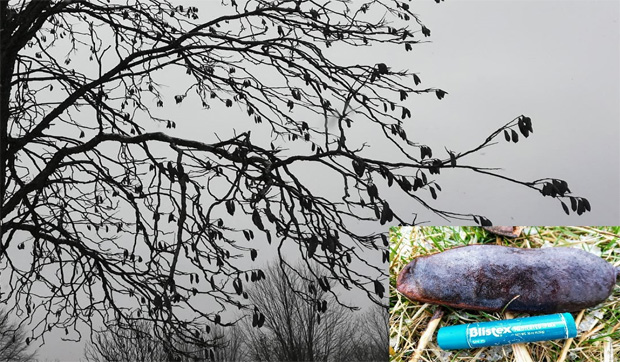The reddish-brown pods of the Kentucky coffeetree contain seeds that were once used as a coffee substitute and, even further back, as food for Ice Age megafauna.
Good Natured: Kentucky Coffeetrees
February 10, 2023
Hey, today let’s have a little coffee klatch! Pour yourself a cup, sit back and enjoy the story of Gymnocladus dioicus, the Kentucky coffeetree.
These eye-catching trees, with their sparse branches and chunky seed pods, are a fairly common site in parks and along streets in St. Charles and other suburban communities.
They’re planted with regularity, thanks to their tolerance of conditions like drought, nutrient-poor soils and road salt; they’re also valued for their open canopy, which allows light to pass thru and enables grass to grow underneath.
Notice though that none of these fine qualities have anything to do with actual coffee. That part of the tree’s name dates back a couple hundred years, to a time when early pioneers were anxious to find something that resembled the warming beverage they remembered from home.
Yes, the seeds-which look like large, dark lima beans-can be roasted, ground and boiled. But as 19th Century horticulturist Andrew Jackson Downing noted, “…when communication was established with the sea-ports, [the settlers] gladly relinquished their Kentucky beverage for the more grateful flavor of the Indian berry; and no use is at present made of it in that manner.”
So today as we drive to Starbucks and Dunkin’ Donuts, we pass by Kentucky coffeetrees on our parkways and traffic islands, giving them barely a second thought. But don’t let their commonness fool you. If it weren’t for our municipalities’ planting efforts, this tree would probably be quite rare. Why? Because, last time I checked, we here in St. Charles-as well as pretty much everyone, everywhere else-were fresh out of…
Mastodons.
Bet you didn’t see that coming! Maye a little more explanation is in order.
As is the case with many plant species in our area, Kentucky coffeetrees date back through the millennia, to a time when king-size animals known as megafauna roamed the land. Mastodons were megafauna, as were mammoths, giant ground sloths and saber-toothed cats. These critters ate, slept and reproduced just as our deer, raccoons and coyotes do today, but they did so during the Ice Age, the time when glaciers covered our landscape.
As the animals were going about their business, plants like the Kentucky coffeetree also were trying to survive. One primary need was, and remains today, a mechanism of seed dispersal. Anchored by roots in the ground, a parent plant has little choice but to trust its progeny-in the form of seeds-to either wind, water, or some sort of animal transportation. (Picture dandelion seeds blowing in the summer air, or American lotus pods floating along the Mississippi. Oh, don’t forget those burs you and your dog pick up on walks. They’re just one more example, albeit an annoying one, of an amazingly successful seed dispersal strategy.)
Anyway, way back when, the Kentucky coffeetree developed its characteristic thick pods, which are lined with a pulp that is sticky and sweet (and toxic to some animals), as a means of encouraging megafauna like mastodons to graze upon them. A big bite, a little chewing, and down the pods went into the jumbo creature’s digestive system. The pods and pulp would be processed and eliminated, but the seeds would pass through mostly whole-with just a little roughing up so as to promote germination later down the line. With any luck at all, by the time the seeds emerged the critter would have traveled a substantial distance, and the tree would have achieved its goal of dispersing its next generation.
But with the passage of time, the mastodons and other megafauna faded away, leaving plants like the Kentucky coffeetree fresh out of dispersal agents. Without a means of sending seeds away, the distribution of these plants became smaller and smaller. If it weren’t for the Kentucky tree’s desirable qualities, which led people to cultivate it and expand its range, the tree might well have gone the way of its dear, departed dispersal agents.
Plants such as these that have been left high and dry, so to speak, by the whims of climate change and evolution, are known as ecological anachronisms. Osage orange (a.k.a. hedge apple) trees are another such organism in our area, as are honey locusts and the imported ginkgo. (If this topic fascinates you the way it does me, you might want to check out the book, “The Ghosts of Evolution: Nonsensical Fruit, Missing Partners, and Other Ecological Anachronisms” by Connie Barlow. Neat stuff there, and a fun read, too.)
Keep an eye open for Kentucky coffeetrees this winter. With their thick, widely-spaced branches and stout pods, they’re easy to spot. And if you happen to spot a mastodon grazing upon one…you might want to check what else is in your coffee…
Pam Otto is the outreach ambassador for the St. Charles Park District. She can be reached at potto@stcparks.org.

